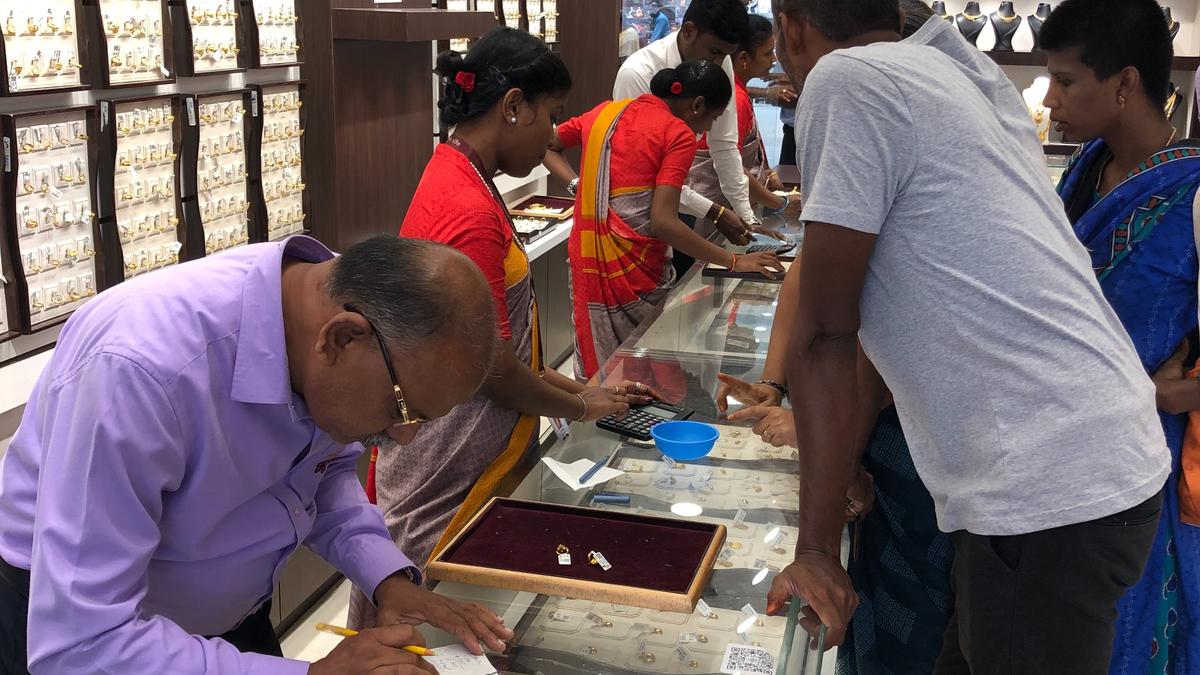
Jewellery showrooms draw heavy crowds on Akshaya Tritiya
The Hindu
Jewellery showrooms and shops in the city drew heavy crowds on Friday on the occasion of Akshaya Tritiya, which is believed to be an auspicious day by Hindus to buy gold
Jewellery showrooms and shops in the city drew heavy crowds on Friday on the occasion of Akshaya Tritiya, which is believed to be an auspicious day by Hindus to buy gold.
Many jewellery shops, which usually open around 9 a.m. on N.S.B. Road, Chinnakadai Veedhi, Big Bazaar Street, Big Kammala Street, and so on started doing business around 7.30 a.m. The showrooms made special arrangements to display ornaments such as bangles, chains, studs and others. To cash in on the sentiment, the showrooms had made advance bookings in the run up to the Akshaya Tritiya. The people, who made advance bookings, visited their respective showrooms to take delivery. Sultry weather did not deter the customers, mainly women, in thronging the jewellery showrooms.
According to bullion traders, gold rate has been on an upward trend for the last two months. The current phase is said to be exponential in recent history. The rate went up on Friday too.
One gram of gold (24 carat) was sold for ₹7,240 on Friday in Tiruchi, up by ₹155 than what was the price on Thursday. The high rate did not deter the buyers.
“Sales was brisk since early morning. We did not have time to take a break,” said S. Anand, proprietor of a jewellery showroom in Thennur.
“We had doubts whether the exponential increase in gold rates would make a dent on Akshaya Tritiya day. But customers showed enormous interest as usual. In fact, the business was better than last year. Jewellery like rings, earrings, and studs were sold like hot cakes,” said M.K.R. Senthilkumar, proprietor of a jewellery showroom in Ariyalur.

“Writing, in general, is a very solitary process,” says Yauvanika Chopra, Associate Director at The New India Foundation (NIF), which, earlier this year, announced the 12th edition of its NIF Book Fellowships for research and scholarship about Indian history after Independence. While authors, in general, are built for it, it can still get very lonely, says Chopra, pointing out that the fellowship’s community support is as valuable as the monetary benefits it offers. “There is a solid community of NIF fellows, trustees, language experts, jury members, all of whom are incredibly competent,” she says. “They really help make authors feel supported from manuscript to publication, so you never feel like you’re struggling through isolation.”

Several principals of government and private schools in Delhi on Tuesday said the Directorate of Education (DoE) circular from a day earlier, directing schools to conduct classes in ‘hybrid’ mode, had caused confusion regarding day-to-day operations as they did not know how many students would return to school from Wednesday and how would teachers instruct in two modes — online and in person — at once. The DoE circular on Monday had also stated that the option to “exercise online mode of education, wherever available, shall vest with the students and their guardians”. Several schoolteachers also expressed confusion regarding the DoE order. A government schoolteacher said he was unsure of how to cope with the resumption of physical classes, given that the order directing government offices to ensure that 50% of the employees work from home is still in place. On Monday, the Commission for Air Quality Management in the National Capital Region and Adjoining Areas (CAQM) had, on the orders of the Supreme Court, directed schools in Delhi-NCR to shift classes to the hybrid mode, following which the DoE had issued the circular. The court had urged the Centre’s pollution watchdog to consider restarting physical classes due to many students missing out on the mid-day meals and lacking the necessary means to attend classes online. The CAQM had, on November 20, asked schools in Delhi-NCR to shift to the online mode of teaching.









